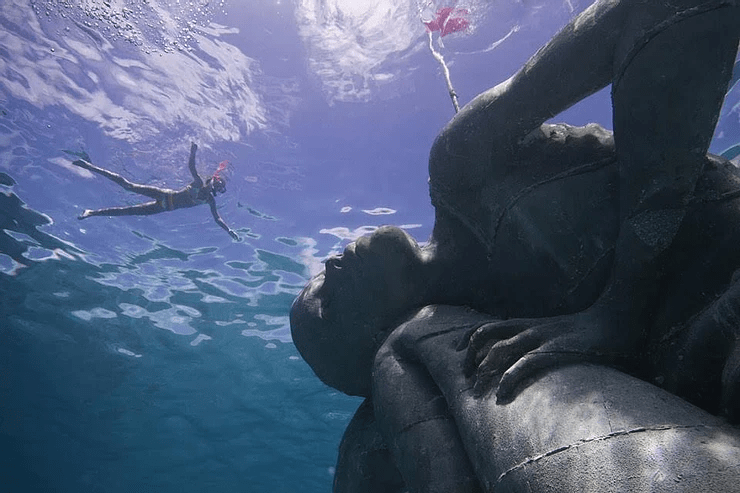Submerge yourself in the turquoise waters off the coast of Clifton Pier and you will find yourself face-to-face with a magnificent little girl. Perched on the ocean floor with the waters’ edge lightly on her shoulders, she and many others like her will one day become one with the marine life that surround them.
Millions of divers, snorkelers and adventurists from around the globe are flocking to The Bahamas for ‘Ocean Atlas,’ the world’s largest single underwater sculpture. The sculpture which is tucked away in waters just off the coast of the national historical park at Clifton Pier, is a part of the Sir Nicholas Nuttall Coral Reef Sculpture Garden.
The underwater art exhibit was commissioned a year ago at Clifton Heritage National Park to draw attention to the endangered marine life that are threatened by oil spills and other industrial traffic.
Executive Director of the Bahamas Reef Environment Educational Foundation (BREEF) Executive director, Casuarina McKinney-Lambert called the sculpture garden the perfect marriage of art, marine education, and conservation for a truly unique experience.

Birthed from a promise between BREEF founder, Sir Nicholas and Bahamian artist Willicey Tynes, the underwater sculpture is a result of the pairs desire to combine their passions for environmental conservation and education. Given its historic significance, Sir Nicholas found that Clifton Pier was the perfect spot for the garden as one of the most needed protective sites in the country.
“It all started with an idea, a concept to create what had never been done in the Bahamas before,” Tynes said.
Tucked away on the southwestern tip of New Providence, where the 1987 American thriller Jaws 4: The Revenge was filmed, Clifton Pier is a protected conservation park and historical landmark. Long before Jaws beach got its name, Clifton Pier was once a slave plantation. Remnants of the John Wood plantation are trekked daily as part of nature walks, guided tours and, of course, those headed for the sea.
Tynes and fellow Bahamian artist, Andret John joined forces with internationally renowned sculptor, Jason DeCaires Taylor, a contributor to the ‘Ocean Atlas’ project; have added the three pieces to the underwater art exhibition.
The statues begin as a fiberglass mold, and are then caste with bio-grade cement and cured. Then, the sculpture was transported by a barge and lowered with a crane to the ocean’s floor. Finally, it was anchored into the seabed.
Tynes’ ‘Virtuoso Man,’ which started as a clay sculpture, pays homage to older Bahamians that are passing to young Bahamians a message of responsibility of protecting the environment. John’s ‘Arawak Face’ is a history lesson to a lost civilization that once roamed the Bahamas.

Divers install ‘Arawak Face’ to the sea bed at Clifton Pier.
“Growing up in the Bahamas, we’re taught about the Arawak, but it’s very rudimentary, it’s very story book without any real, substantial experience with those people… this piece gives you a glimpse—these were people just as we are now,” said John in describing the inspiration behind ‘Arawak Face.’
Weighing over 60 tons, Ocean Atlas kneels on the ocean floor, towering 18 feet to the surface. Taylor’s piece is not his first underwater sculpture, as he has put hundreds of life-sized sculptures throughout the world, from Greece to Grenada. He leads the world in underwater sculpture installations and instructed Tynes on how to continue this project.
Based on the aquatic engineering, including current and tide flow, past hurricane projections and sea swells, the underwater sculpture garden was erected at the perfect spot.
Although only a few pieces have been installed, the underwater sculpture garden has attracted a kaleidoscope of marine life, including coral reef, to form. Made from sustainable PH-neutral materials, the Sculpture Garden will develop biological growth and take on a new look and color each year. Through a metamorphosis, the pieces will change shape and eventually this underwater area will be totally assimilated into the surrounding marine life.
While highlighting the natural beauty of the island and coral reef, the Sculpture Garden also brings attention to the man-made threats to wild and marine life in that area.
The Bahamas Government spent $10 million to clean up the affected Clifton Pier and surrounding areas earlier this year. Since then, however, divers and nearby businesses that rely on the natural marine resources have reported seeing spots of crude oil in the ocean. Such discoveries have only made the mission of these contributing artists even more important.

Tynes’ ‘Virtuoso Man’ is erected on the seafloor, just off the coast of Clifton Pier.
Hopeful that as people fall in love with the underwater sculpture garden that they will become environment ambassadors, Tynes said all Bahamians and visitors should vow to use their influence and power to protect what only few countries in the world can boast of having.
“The man-made sculptures were constructed to be artificial reefs for marine life to colonize and inhabit. We desire that this sculpture garden becomes a sanctuary for other sea life and for future generations of our young ones, minus the oil spills,” Tynes said.
John described the project as “a process of using art to educate.” Well, that process has garnered the Bahamas international attention, including international media giant, Vice, which flew in a team to shoot a documentary on the project.
As the Sculpture Garden continues to provide a haven for endangered marine life, the artists are preparing to install new sculptures and designs for Phase 2 and Phase 3 next year, pending funding. Meanwhile, BREEF offers outdoor, under the sea classrooms for young sea lovers.

Hi, this is a comment.
To get started with moderating, editing, and deleting comments, please visit the Comments screen in the dashboard.
Commenter avatars come from Gravatar.
Comments are closed.